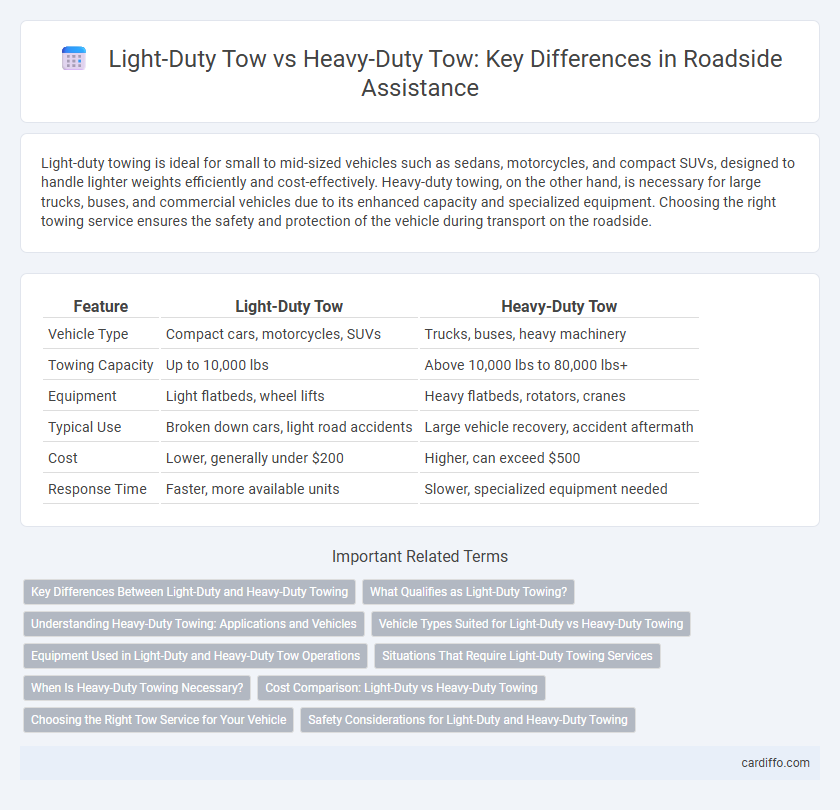Light-duty towing is ideal for small to mid-sized vehicles such as sedans, motorcycles, and compact SUVs, designed to handle lighter weights efficiently and cost-effectively. Heavy-duty towing, on the other hand, is necessary for large trucks, buses, and commercial vehicles due to its enhanced capacity and specialized equipment. Choosing the right towing service ensures the safety and protection of the vehicle during transport on the roadside.
Table of Comparison
| Feature | Light-Duty Tow | Heavy-Duty Tow |
|---|---|---|
| Vehicle Type | Compact cars, motorcycles, SUVs | Trucks, buses, heavy machinery |
| Towing Capacity | Up to 10,000 lbs | Above 10,000 lbs to 80,000 lbs+ |
| Equipment | Light flatbeds, wheel lifts | Heavy flatbeds, rotators, cranes |
| Typical Use | Broken down cars, light road accidents | Large vehicle recovery, accident aftermath |
| Cost | Lower, generally under $200 | Higher, can exceed $500 |
| Response Time | Faster, more available units | Slower, specialized equipment needed |
Key Differences Between Light-Duty and Heavy-Duty Towing
Light-duty towing typically involves vehicles weighing up to 10,000 pounds, such as sedans and small SUVs, requiring tow trucks with lower horsepower and simpler equipment. Heavy-duty towing handles commercial trucks and large vehicles exceeding 33,000 pounds Gross Vehicle Weight Rating (GVWR), demanding powerful trucks with reinforced frames and advanced hydraulic systems for safe recovery. Key differences include tow capacity, equipment strength, and the specialized training needed for operators to manage heavier loads efficiently.
What Qualifies as Light-Duty Towing?
Light-duty towing typically involves vehicles weighing up to 10,000 pounds, such as cars, small SUVs, and light trucks, requiring minimal equipment and effort for recovery or transport. This category covers common roadside assistance tasks like jump-starts, tire changes, and towing disabled passenger vehicles from breakdown sites. Light-duty tow trucks are equipped with flatbeds, wheel lifts, or hook and chain systems designed for agility and quick response in urban or suburban environments.
Understanding Heavy-Duty Towing: Applications and Vehicles
Heavy-duty towing involves vehicles such as commercial trucks, buses, and large RVs requiring specialized equipment like heavy-duty wreckers and rotators designed for substantial weight and size. Applications include recovering disabled semi-trucks, removing oversized construction equipment, and assisting multi-axle trailers, where standard light-duty tow trucks lack the capacity. Understanding these differences ensures appropriate vehicle dispatch, enhances safety during recovery operations, and minimizes roadside delays.
Vehicle Types Suited for Light-Duty vs Heavy-Duty Towing
Light-duty towing is ideal for small to medium-sized vehicles such as sedans, SUVs, and motorcycles, handling loads typically under 10,000 pounds. Heavy-duty towing suits larger vehicles including commercial trucks, buses, and RVs, managing weights exceeding 26,000 pounds with specialized equipment. Choosing the correct tow truck based on vehicle size ensures safety and efficiency during roadside recovery operations.
Equipment Used in Light-Duty and Heavy-Duty Tow Operations
Light-duty tow operations utilize equipment such as flatbed trucks, wheel-lift tow trucks, and dollies designed for vehicles weighing up to 10,000 pounds. In contrast, heavy-duty tow operations employ powerful wrecker trucks, multi-axle trailers, and hydraulic cranes capable of handling commercial vehicles and machinery exceeding 30,000 pounds. The distinction in equipment ensures safe and efficient recovery tailored to the weight and size of the vehicle involved in roadside incidents.
Situations That Require Light-Duty Towing Services
Light-duty towing is essential for situations involving compact cars, motorcycles, and small SUVs that require quick, safe transport from minor accidents or breakdowns. This towing method handles vehicles up to 10,000 pounds, ideal for flatbed or wheel-lift tow trucks navigating urban areas or tight spaces. Choosing light-duty services ensures minimal damage risk while efficiently resolving roadside immobilizations without the need for heavy-duty equipment.
When Is Heavy-Duty Towing Necessary?
Heavy-duty towing becomes necessary when vehicles exceed 15,000 pounds, such as large trucks, buses, or construction equipment that light-duty tow trucks cannot safely handle. These specialized tow trucks are equipped with reinforced frames, powerful engines, and advanced rigging systems to manage the size and weight of heavy-duty vehicles. Opting for heavy-duty towing ensures safe transportation and prevents damage to both the vehicle being towed and public roadways.
Cost Comparison: Light-Duty vs Heavy-Duty Towing
Light-duty towing typically costs between $75 and $125 per hour, making it ideal for smaller vehicles like cars and motorcycles, while heavy-duty towing ranges from $125 to $250 per hour due to the need for specialized equipment and vehicles such as trucks and buses. The higher price of heavy-duty towing reflects increased labor, more powerful tow trucks, and additional safety measures required for larger loads. Choosing the appropriate service affects not only the towing efficiency but also the overall roadside assistance expense based on vehicle size and towing complexity.
Choosing the Right Tow Service for Your Vehicle
Light-duty tow services are ideal for smaller vehicles such as sedans, motorcycles, and compact SUVs, offering quick and efficient assistance for minor breakdowns or parking enforcement. Heavy-duty tow services cater to larger vehicles like trucks, buses, and commercial trailers, requiring specialized equipment and increased towing capacity to ensure safe transport. Selecting the appropriate tow service depends on your vehicle's weight, size, and the towing equipment needed to prevent damage and ensure a smooth recovery.
Safety Considerations for Light-Duty and Heavy-Duty Towing
Light-duty towing involves towing smaller vehicles such as sedans, SUVs, and light trucks, requiring less powerful equipment but higher attention to balance and connection points to prevent sway and accidents. Heavy-duty towing demands robust tow trucks designed to handle large commercial vehicles like buses and semi-trucks, emphasizing reinforced tow arms, advanced braking systems, and strict adherence to weight limits for enhanced safety. Proper assessment of vehicle weight, secure hitching, and professional operator training are critical in both light-duty and heavy-duty towing to minimize road hazards and ensure the safety of all road users.
Light-duty tow vs heavy-duty tow Infographic

 cardiffo.com
cardiffo.com